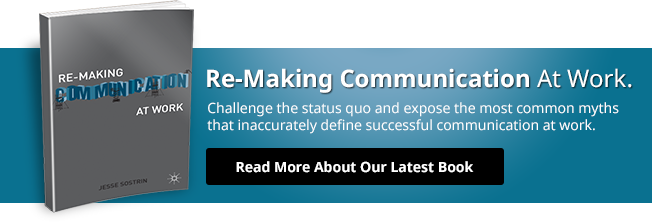Stop Trying to “Improve” Communication, You Have to Re-Make It
Many have tried and just as many have failed. Well-meaning and highly skilled supervisors, trainers, executive coaches, management consultants, and human resources professionals have all accepted the challenge of “improving” communication within their teams.
For those of us who have had the wonderful experience of attending a communication skills workshop of some kind, only to return to the workplace the next day to endure the same recurring, destructive patterns of interaction that prompted the need for training in the first place; you know something is wrong with this picture.
No stones thrown here; the first workshop I facilitated was focused on improving communication and engagement with first year college students to increase retention rates for the university. In the ensuing decades there has not been a single intervention that I have delivered—as a conflict resolution specialist, group facilitator, executive coach, organization development consultant, and human resources executive— that has not at least touched on the theme.
After years of wrestling with the frustrating gaps between intervention and actual change, I have come to a conclusion: We need to stop trying to “improve” communication. We have to actually re-make it.
Perhaps the most inescapable demand of work is the need to communicate with other people. For individual contributors, the quality of the communication they engage in directly reflects their relationships with coworkers, the level of motivation and engagement they feel, the impact and performance they contribute, and the general quality of their working lives.
For leaders, the quality of the communication they engage in directly reflects their relationships with their direct reports, the capacity to motivate and engage people, the alignment of team performance with company goals, capacity to manage complexity and change, and the overall influence of their leadership on vital benchmarks like workforce retention and productivity and ultimately culture.
Re-making communication at work boils down to one simple idea: The experiences and outcomes you get at work are made in the specific patterns of communication and interaction you engage in. If you want something different in your everyday experience at work or in the long-term arc of your career, you have to make that change by altering your fundamental building blocks of communication.
For example, if you strive to be an effective leader that achieves results, inspires others, and adds lasting value to your organization, you will achieve that impact by creating the patterns of communication that create the conditions for you to deliver these results. Once you fully integrate this concept, exercise the principles, and practice the tools, you re-make communication at work when you:
- Take a communication perspective and understand that meetings are not just meetings and conversations are not just conversations. The everyday episodes of interaction that play out in our working lives are governed by rules and they move us closer to or further away from the outcomes and experiences we seek.
- Recognize your patterns of communication and interaction where decisions get made, relationships are built, organizational culture is solidified, and the trajectory for ultimate business outcomes are set into motion.
- Examine what you make and select unwanted patterns to re-make. Spot the critical moments where something different/better could be made, understand how to create the flexible conditions for change, and learn to avoid everyday pitfalls that can undermine the new patterns and the benefits they bring.
- Gain a significant competitive advantage by re-making communication at work. Perhaps one of the most significant sources of competitive advantage is the capacity to literally re-make unwanted patterns into coordinated efforts that align people with priorities, bring out the best in people’s talent and motivation, and boost learning and performance by closing the inevitable gaps that emerge when things go bad.
While it may seem simpler to rely on the conventional wisdom of effective communication at work—“Choose your words more carefully, consider the listener as you craft the message, actively listen until they are done speaking, don’t forget about the power of non-verbal cues, build trust through empathy and validation of others’ experience, set aside your own emotions in order to hear the speaker’s message when things get tense, build rapport so you can rely on that during difficult conversations, communicate assertively by advocating for your own ideas without shutting others down, and be persuasive by mirroring other people’s style of communication”—these simple prescriptions, which are all based on efforts to just “improve” communication, are just not enough to thoroughly address the difficult challenges of communication.
In order to match the dynamic, complex nature of the challenge of communication at work, an equally dynamic and flexible process is needed to address them in the real world of work. The new definition of “useful” communication at work starts with the ability to recognize the patterns of communication and interaction where decisions get made, relationships are built, organizational culture is solidified, and the trajectory for ultimate business outcomes are set into motion.
When you learn to apply the principles and tools of re-making communication at work you are less concerned with “improving” communication and more equipped to simply create more of the patterns that produce the experiences and outcomes you want, and fewer of the ones you don’t.
Dr. Jesse Sostrin is available to help you identify and re-make your team’s critical patterns of communication that produce unwanted outcomes such as breaches of trust, failures of collaboration, poor productivity and performance, fragmented organizational culture, and more. To learn more, start your discovery session now.

